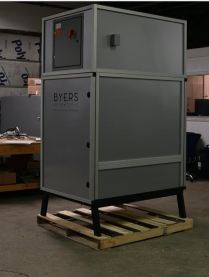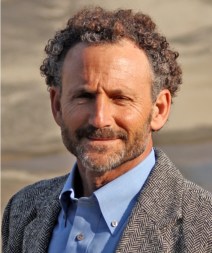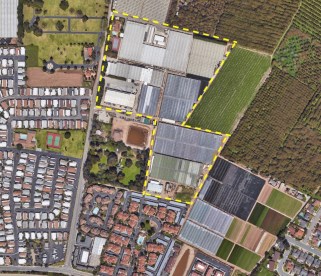For the past three years, the “skunky” stench of marijuana swirling around Carpinteria, penetrating homes, schools, parks, beaches, freeway lanes, and even funerals at the cemetery has pitted neighbor against neighbor as the cannabis greenhouse industry exploded just outside the city limits.
Now, some technological advances — combined with a groundbreaking odor-control agreement between one of Carpinteria’s oldest farming families and several members of the citizens’ groups that have fought for tighter regulation of the cannabis industry — are upping the ante for future projects.

The pact between Cindy and David Van Wingerden of CVW Organic Farms and members of Concerned Carpinterians and the Santa Barbara Coalition for Responsible Cannabis goes well beyond what’s required under the county’s lenient (some would say, grossly lax) cannabis ordinance.
A few growers have committed to air-quality tests, and some are investing in new technology; they, too, are eager to end the raging pot wars in this once-peaceful seaside community. But it is the Van Wingerdens’ plan that is the most far-reaching. County Planning Commissioner Mike Cooney, who represents the Carpinteria Valley, has called it “a real gold standard — as good as it gets.”
“Above all the others in the Carpinteria area, this project offers the potential for solving the odor problem that has been presented to us painfully over the last couple of years,” Cooney said. “I liken it to discovering a vaccine that’s going to end the pandemic we’ve had of odor throughout the valley.”
New Technology
On December 2, in a first for the county — and for North America — the commission approved a zoning permit for CVW Farms that requires the installation of cutting-edge carbon air filtration systems, or “scrubbers,” inside 346,000 square feet of cannabis greenhouses and a two-story, 36,000-square-foot processing building. The 16-acre property is at 1296, 1400, and 1480 Cravens Lane, next to the city boundary. All but one of the greenhouses there are presently in Gerbera daisies and cymbidiums.

The scrubbers are designed to get rid of the stinky smell of pot before it escapes from the greenhouse roof vents. They would run when the vents are closed and blackout curtains are down, chiefly at night. In test runs, the scrubbers have been shown to remove nearly all the smelly gases generated by cannabis. The Van Wingerdens will install 30 scrubbers in all, including next door in their greenhouses at 1540 Cravens Lane.

As a backup, odors that escape outdoors during the day will be neutralized by a “curtain” of vapor made from plant oils that is released through perforated pipes suspended on the outside of the greenhouses. The vapor system is currently the frontline odor-control technology in most Carpinteria “grows.” But, judging by the persistently smelly hot spots around town and the number of odor complaints — 867 filed with the county since June of 2018 — it doesn’t always work.
The vapor systems and scrubbers were designed and engineered by Marc Byers, a Summerland resident who owns Byers Scientific, an industrial odor-management firm. The cost of this equipment for the Van Wingerdens’ projects will be between $350,000 and $500,000, he said.
‘Open Dialogue’
In a written statement this week, Cindy Van Wingerden said she and David wanted carbon scrubbers for their greenhouses “as soon as we learned that this extra layer of odor treatment could be effective.” Their farm lies in close proximity to several residential neighborhoods — the Franciscan Villas, Seahouse development, and Sandpiper Mobile Home Park.
“David and I value peace with our neighbors and open dialogue,” Cindy wrote. “We have a long history of operating our agricultural businesses responsibly on Cravens Lane, and we have worked in tandem with our neighbors to address their concerns for decades. It is the same for cannabis.”

The City of Carpinteria has long pressed the county to rein in the cannabis farms that are operating or preparing to operate in the valley — nearly 40 in all. In a recent letter to the commission about CVW Farms, Nick Bobroff, a principal city planner, said, “We are cautiously optimistic that this project … will be successful at peaceably coexisting with adjacent residential developments located in the City of Carpinteria.”
Marc Chytilo, a coalition attorney who has sued the county and four cannabis growers on behalf of the coalition, said the Van Wingerdens’ odor-control plan was “a significant accomplishment” and “should be a model” for other farms.
“We’ve made some real progress,” he said. “We’re pleased to be working with responsible growers who can step up and make a difference. I think that the whole industry is aware how much this could help resolve the regional conflicts that have arisen. They don’t want an appeal on every project.”
Monitoring the Smell
The odor-control plan that was drawn up by the Van Wingerdens and their neighbors also has been incorporated into the zoning permit for cultivation at 1540 Cravens, where the couple plans to convert additional flower greenhouses to cannabis. In all, there will be nearly 600,000 square feet of cannabis cultivation at CVW Farms when the projects are complete.
In addition to using scrubbers, the Van Wingerdens are required to install weather-monitoring equipment to collect data about the shifting winds that blow the smell of marijuana around the valley. They will hire a vapor-monitoring service that uses a gas chromatograph to test the air for cannabis molecules. The service will be used for seven days at the start of their first cannabis harvest, when the smell of the budding plants is most pungent. Samples will be taken on the premises and even in neighbors’ yards.

This air-quality-sampling service, called VaporSafe, is the first to analyze cannabis odors in the field; the samples do not have to be sent to a lab. The service was invented by Mark Kram, a Santa Barbara chemist and hydrogeologist who can boast that he was one of the first PhD graduates of the UCSB Bren School of Environmental Science & Management. Kram has deployed his service at toxic Superfund sites; over the past year, he repurposed it for cannabis. It costs up to $2,000 per day.
Finally, the Van Wingerdens must personally field all odor complaints, report them to the county, and fully investigate the source of the odors. If problems persist, they will be required to upgrade their odor-control system with the “best available control technology” if it is “reasonably available.”
“We hope it works,” Cooney said of the odor-control plan. “But if something goes wrong, there will be more input and more opportunity to correct it.”
The plan specifically “ensures that odors will be generally confined to the cannabis activity site and not beyond the property line” — language that appears nowhere in county ordinances. The county requires growers only to “prevent odors from being experienced within residential zones.”
The county Board of Supervisors majority, including Das Williams of Carpinteria, a chief architect of the cannabis ordinance, this year rejected a commission recommendation that would have required all cannabis operations to be “compatible with the surrounding area” and “not detrimental to the comfort, convenience, general welfare, health, and safety of the neighborhood.”
When residents file odor complaints, county officials often can’t find the source. Even if they can, they have no authority to require a remedy unless the grower in question has a zoning permit. Most Carpinteria growers are operating under “legal, non-conforming” status while their permit applications are undergoing county review.
Cooney concedes that the Van Wingerdens’ plan “may be a bridge too far for the Carpinteria cannabis industry.” But he invites other growers to “line up here if you’re willing to accept the conditions attached to this project, and we will give you a permit the same day.”
‘Foundation of Trust’

In going beyond the ordinances, the Van Wingerdens sought to avoid conflict in a community where their family has been farming for 50 years. They had been thriving in the bouquet business, but as South American imports flooded the market, they struggled to stay afloat.
Some growers and supporters have called coalition members “elitists,” “Not-In-My-Backyard NIMBYs,” and “Prohibitionists.” Even Williams has suggested that some residents will never be satisfied, no matter what the county does.
But the Van Wingerdens thought differently, and they reached out. This fall, the couple spent weeks hammering out an odor-control plan with Judy Dean, Anna Carrillo, and Rob Salomon of Carpinteria; Chytilo, the coalition’s lawyer, who worked on the plan pro bono; and their own attorney, Amy Steinfeld.
Initially, Cindy said, they contacted Salomon and Dean, “since they both live on Cravens Lane, and we felt that it was our neighborly duty to understand their concerns.” After many discussions, she said, “We established a strong foundation of trust, which allowed us to cooperate in developing an odor response and monitoring plan and ultimately reach a settlement …”
Dean, a medical doctor, had appealed the Wingerdens’ project at 1540 Cravens after it was approved for a zoning permit by county planning staff. She told the commission that she believed she had contracted asthma, suffered from dizziness, and had trouble sleeping because of the noxious odors from nearby cannabis operations.
“I encourage the commissioners to visit Carpinteria and smell for themselves,” Dean wrote in an August 26 letter, naming such hot spots as Via Real and Foothill Road between Cravens and Nidever Road, Carpinteria High School along Foothill, and the intersection of Foothill and Casitas Pass Road. Residents in these neighborhoods have long complained of headaches, watery eyes, sore throats, and respiratory problems from the stench of marijuana.
“If you live here, hardly a day goes by that you don’t smell cannabis,” Dean wrote.
Last week, Dean withdrew her appeal in a letter to county staff, citing the Van Wingerdens’ “diligent efforts” and “willingness to work with the community.”
“I look forward to a time when the county makes a meaningful effort to address the air-quality problems cannabis is introducing in our communities,” she wrote.
‘Science Lab’
The CVW project sets a high bar for three dozen other cannabis greenhouse operations in Carpinteria Valley, 10 of them owned by members of the extended Van Wingerden family.

Cindy and David Van Wingerden hope their farm will serve as a “science lab” for testing and refining odor-control technology. But it’s not clear whether other growers will voluntarily follow their lead. The carbon scrubbers alone cost between $12,000 and $16,000 each. One Byers vapor system costs $47,000, and a large cannabis operation may need several.
Graham Farrar, vice-president of the Cannabis Association for Carpinteria (CARP) Growers, representing 14 cannabis operators with 22 farms, called the Van Wingerdens’ agreement with the coalition “awesome and incredibly more productive than the appeal pathway that accomplishes very little that’s constructive and is expensive for the grower.”
“I would rather see growers spend money on filters that people want rather than on lawyers,” Farrar said. “An appeal can cost more than $100,000.”
But Farrar regards Byers’s carbon scrubbers and Kram’s vapor monitoring system as unproven technologies. Cindy and David Van Wingerden, he said, are “signing up for stuff that may not actually resolve the community’s issue … We’d like to do some testing and prove what works.”
Farrar said CARP Growers plans to pay for and install a regional weather-monitoring network that can more accurately pinpoint the sources of cannabis odors and show how they travel around the valley.
Most Carpinteria growers, including Farrar, use the Byers vapor system, which was originally designed for solid waste. It relies on a blend of plant oils and water called Ecosorb, which is vaporized to mix with and neutralize the smelly gases from cannabis in the outside air.
But the vapor system gets periodically overwhelmed in the early morning when blackout curtains are raised and the greenhouse vents are opened, or “burped.” Many residents have come to expect a stink at that time of day. They also report that Ecosorb has an irritating soapy “laundromat” smell, and they question whether its safety has been sufficiently studied. Byers says the vapor smells like lemons and notes that it is used in hospitals for odor control. The county Air Pollution Control District has found no air toxins in Ecosorb.
In search of something better, Byers says he spent 18 months designing his carbon air filtration systems for cannabis greenhouses and processing buildings. He’s already received orders for 57 scrubbers in Carpinteria. He believes they will reduce the need for Ecosorb by 50 percent.
No Size Fits All
Every “grow” is different; some are not located near residences, and each must contend with a unique micro-climate. With Byers’s help, Collin Dvorak, the owner of Pacific Grown Organics, is trying something new at his long and narrow cannabis greenhouse at 5892 Via Real. Instead of scrubbers, he’s installing a Byers vapor system inside the greenhouse in a closed chamber, where the smell of marijuana can be neutralized more efficiently. Fans mounted on one side of the building will force the air into the chamber on the other side.
Dvorak hopes to begin cultivation next year. In September, he became the first grower in the county to negotiate an odor-control agreement with the coalition; the Van Wingerdens used it as a model for theirs. Dvorak’s project had been approved by county staff, but it was appealed. That’s when Dvorak started meeting with coalition members in their front yards and his own.
“I knew I was going to have to look someone in the face and tell them I was doing all I could,” he said. “Essentially, I’m having to self-regulate, going far beyond the ordinance.”
Dvorak said he “certainly received a lot of blowback” from growers who thought he had gone too far.
“There’s a general sentiment that the concessions that are made will never be enough,” he said. “But this is not a couple of cranky neighbors who have nothing better to do. If we want to have the strongest cannabis hub in California, we should be willing to address the concerns that our community has. The industry needs to turn and confront this with sobriety. We need to do more.”
Melinda Burns volunteers as a freelance journalist in Santa Barbara as a community service. She offers her news reports to multiple local publications, at the same time, for free.
Every day, the staff of the Santa Barbara Independent works hard to sort out truth from rumor and keep you informed of what’s happening across the entire Santa Barbara community. Now there’s a way to directly enable these efforts. Support the Independent by making a direct contribution or with a subscription to Indy+.





You must be logged in to post a comment.